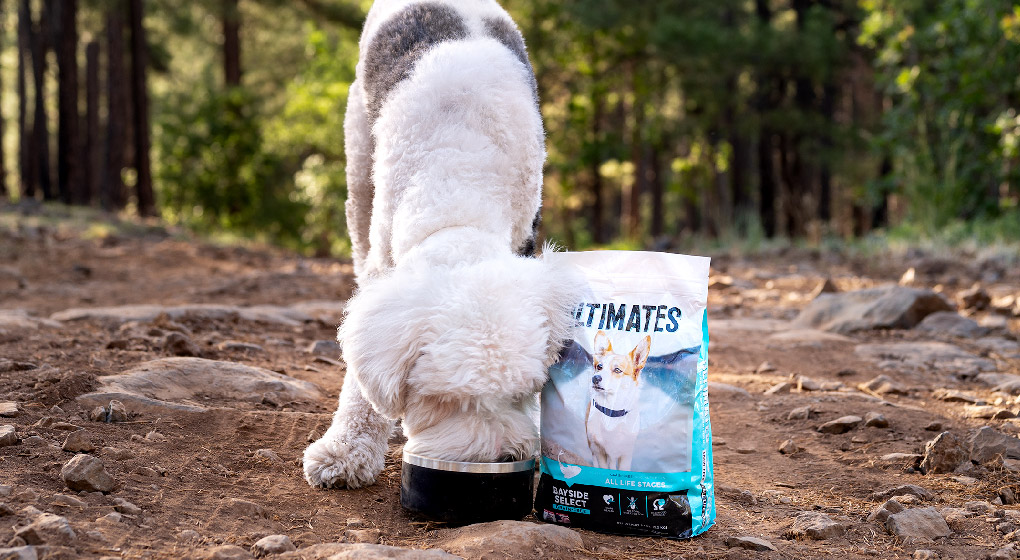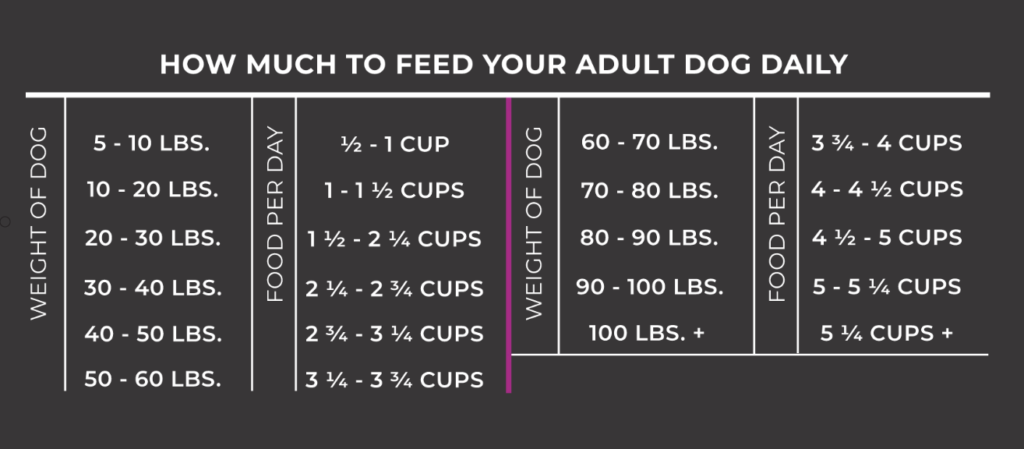How Much Food Should I Feed My Dog?
Are you confused about how much food you should feed your dog? The truth is, many pup parents struggle with this question, but don’t worry – we’ve got you covered!
In this guide, we’ll explore your dog’s nutritional needs and how to calculate food portion sizes. Plus, we’ll take a look at other factors that may affect your dog’s food intake and how to monitor their health and weight.

Understanding Your Dog’s Nutritional Needs
Dogs thrive on a diet that fits their unique physical and lifestyle requirements. In this section, we’ll help you understand what those needs are and how they change over the course of your dog’s lifetime.
Basic Nutritional Requirements for Dogs
Dogs need a complete and balanced diet that includes protein, fats, carbohydrates, and essential micronutrients like vitamins and minerals. These nutrients play a vital role in your dog’s growth, energy, and overall health. For example, protein supports muscle growth and repair, fats provide energy and aid in the absorption of vitamins, and carbohydrates supply fiber that aids digestion.
Feeding high-quality dog food is the best way to ensure your dog gets all the necessary nutrients in their diet. That’s why it’s important to do your research and choose a reputable brand that offers complete and balanced meals made with healthy, wholesome ingredients.
Size, Age, Breed, and Health Considerations
The right diet for your dog also depends on their size, age, breed, and overall health. It’s essential to choose a diet that supports your dog’s life stage and adjust their food intake based on these factors to meet their unique needs. Here’s an overview of some of the most important considerations for different types of dogs:
- Puppies need growth support. Their diets should be rich in proteins and fats to help with rapid growth and development. Puppies also require frequent small meals throughout the day to sustain their energy levels without overloading their digestive systems. Make sure to feed your pup a high-quality food that’s specially formulated for puppies or all life stages. Ultimates Puppy, Ultimates Large Breed Puppy, or Ultimates Bayside Select are all excellent choices.
- Senior dogs need maintenance. Older dogs may require fewer calories due to decreased activity levels but still need high-quality protein to maintain muscle mass and overall health. They might also benefit from diets that include joint-supporting nutrients like glucosamine and chondroitin. Our Chicken Meal & Rice recipe for large breed adult dogs is formulated with glucosamine and chondroitin to support healthy joints.
- Small breeds have fast metabolisms. These dogs often need more calories per pound of body weight compared to larger breeds. However, their small stomachs mean that they may require smaller, more frequent meals.
- Large breeds need joint support. Large and giant breeds are prone to joint issues. They may benefit from diets that include specific nutrients for joint health and weight management to prevent excessive stress on their bones.
- Dogs with health conditions may need special diets. If your dog has chronic health issues like diabetes, allergies, or kidney disease, they may require a specific diet tailored to their condition. Make sure to consult with your veterinarian for personalized dietary recommendations.
Calculating the Right Food Portion
Now that we’ve covered the basic nutritional requirements for dogs, let’s take a look at how to determine the right portion size for your pup.
Reading and Understanding Food Labels
Dog food labels are a critical tool in managing your dog’s diet. They provide detailed information about the ingredients and nutritional content, as well as feeding guidelines that can help you determine how much to feed your dog.
The image below shows an example of our Ultimates Lamb Meal & Rice recipe’s feeding chart. The chart shows the weight and recommended cups of food per day based on your adult dog’s weight.

It’s important to remember that all dogs are different, and these feeding guidelines are just a starting point. We recommend speaking to your vet about the best portion sizes for your pup. They will consider factors such as your dog’s breed, size, age, and activity level to determine the right amount of food for them.
Using Weight as a Guide
As we’ve discussed, your dog’s weight is one of the most straightforward guides for determining portion size. That’s why regular weigh-ins are essential for monitoring your dog’s health and ensuring you’re feeding them the right amount.
It’s important to control your dog’s food portions to keep them at a healthy weight and avoid health issues like diabetes and joint problems. Again, your vet can help you determine your dog’s ideal weight and adjust their diet accordingly.
Adjusting Portions for Activity Level
Your dog’s activity level plays a significant role in how much they should eat. Active dogs burn more calories and often require more food. For example, a dog that regularly goes on long walks will need more calories than a dog that prefers short walks and spends most of the day indoors.
Keep in mind that as your dog ages, they might not be as active. So, it’s important to check how much they’re eating and adjust it if necessary to prevent them from gaining too much weight. This is another reason why it’s essential to regularly consult with your vet about your dog’s dietary needs.
Types of Dog Food and Feeding Strategies
Choosing the right type of food and feeding strategy is essential for meeting your dog’s nutritional needs. In this section, we’ll explore different options and how they can fit into your feeding routine.
Dry vs. Wet Food
Dry dog food, or kibble, is the most common and convenient choice for pet parents. It’s affordable, easy to store, and has a long shelf life. However, some dogs may find dry food less palatable and may need additional moisture in their diets.
Wet food, on the other hand, is typically more expensive and has a shorter shelf life. However, it can be a great option for picky eaters or dogs that need to increase their water intake. You can also mix wet and dry food to provide your dog with the benefits of both.
When it comes to portion size, wet food contains a higher moisture content and may require larger serving sizes compared to dry food. It’s essential to check the feeding guidelines on the label and adjust according to your dog’s specific needs.
Incorporating Treats Responsibly
Treats are an excellent tool for training and bonding with your dog, but they should be given in moderation. According to the American Kennel Club, treats shouldn’t make up more than 10% of your dog’s daily diet. This means that if your dog eats 400 calories a day in food then they should only eat 40 calories worth of dog treats per day.
Always choose high-quality treats that provide nutritional value and consider the calories they contain when planning your dog’s meals. It’s best to avoid table scraps, as they’re often high in fat and salt, which can lead to health issues for your dog.
Meal Timing and Frequency
The best feeding schedule for your dog depends on their individual needs. While twice-daily feedings are the most common, some dogs may do better with three or four smaller meals throughout the day.
Your vet will be able to advise you on the best meal timing and frequency for your dog. You should also consider your dog’s activity level and personal preferences when determining the best feeding schedule for them.
Monitoring Your Dog’s Health and Weight
Keeping an eye on your dog’s health and weight is essential for adjusting their diet over time and ensuring they remain in peak condition. Here are some signs to look out for:
Signs of Proper Nutrition
A well-nourished dog should have a shiny coat, clear eyes, healthy skin, and a good body condition score. They should also have normal energy levels and their poop should be firm and easy to pick up. If your dog is displaying these signs, it’s a good indication that their diet is meeting their nutritional needs.
Conversely, if your dog’s coat is dull, their eyes are cloudy, their skin is flaky or they have a poor body condition score, it could be a sign that they need a diet adjustment. Always consult with your vet before making any changes to your dog’s diet.
Identifying Overfeeding and Underfeeding
It’s important to recognize the signs of both overfeeding and underfeeding to adjust your dog’s diet as needed. Overfeeding can lead to weight gain and health issues such as diabetes, while underfeeding can result in weight loss, lethargy, and other health problems.
The main signs of overfeeding include excessive weight gain and difficulty exercising. On the other hand, if your dog is consistently losing weight, has a lack of energy, or seems constantly hungry, they may not be getting enough to eat.
Regular Check-Ups and Adjustments
Regular veterinary check-ups are crucial for monitoring your dog’s health and making necessary adjustments to their diet. Your vet can provide valuable insights into whether your dog’s nutritional needs are being met and help you make any needed changes to their diet.
Make sure to schedule annual check-ups with your vet and discuss any concerns or changes in your dog’s eating habits. By staying on top of their health, you can ensure that they are getting the right amount of food to live a long, healthy life.
Key Takeaways
- Dogs need a complete and balanced diet. Their meals should consist of proteins, carbohydrates, fats, vitamins, and minerals.
- Consider factors like size, age, breed, and health. These all play a role in determining your dog’s nutritional needs.
- Activity levels influence dietary needs. Active dogs require more calories, while less active dogs need fewer to maintain a healthy weight.
- Choose the right type of food and feeding strategy. Whether dry, wet, or a mix, ensure it meets your dog’s nutritional needs and fits their preferences.
- Treats should be given in moderation. They’re important for training and bonding but should not exceed 10% of your dog’s daily caloric intake.
- Maintain a consistent feeding schedule. Tailor meal timing and frequency to your dog’s needs and consult with your vet for advice.
- Monitor your dog’s health and weight regularly. Changes in weight, coat quality, and energy levels can indicate the need for dietary adjustments.
- Adjustments to diet should be made carefully. Always consult with your vet before making changes to your dog’s feeding routine.
Are You Feeding Your Dog Right?
Feeding your dog might seem like a straightforward task, but it’s an essential part of their care that significantly affects their health and wellbeing.
By following the guidelines outlined above, you can ensure that your dog is getting all the nutrients they need to thrive. Just remember to consult with your vet regularly and make adjustments as needed to keep your pup happy and healthy.

